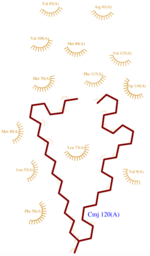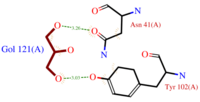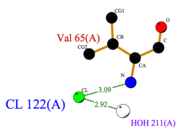Sandbox Reserved 960
From Proteopedia
(Difference between revisions)
| Line 6: | Line 6: | ||
The protein AmelASP1 has been identified in the antennae from the honeybee A.mellifera. Its primary sequence is a 144 amino acids polypeptide with a molecular weight of 13.180 kDa. AmelASP1 is part of the Pheromone Binding Protein (PBP) family. The 3D representation shown below was obtained at pH 5.5 using the nano-drops technique. | The protein AmelASP1 has been identified in the antennae from the honeybee A.mellifera. Its primary sequence is a 144 amino acids polypeptide with a molecular weight of 13.180 kDa. AmelASP1 is part of the Pheromone Binding Protein (PBP) family. The 3D representation shown below was obtained at pH 5.5 using the nano-drops technique. | ||
| + | |||
| + | |||
| + | |||
| + | Updated on {{REVISIONDAY2}}-{{MONTHNAME|{{REVISIONMONTH}}}}-{{REVISIONYEAR}} | ||
| + | |||
| + | <ref>PMID: 18508083</ref> | ||
| + | <ref>PMID: 19481550</ref> | ||
| + | <ref>PMID: 25337796</ref> | ||
| + | <ref>PMID: 14594955</ref> | ||
==Biological function== | ==Biological function== | ||
| Line 21: | Line 30: | ||
| + | == Structure == | ||
| + | [[Image: 3fe6_cartoon.jpg|250px|left|thumb|'''Fig.1''' Ribbon colored representation]] | ||
| - | ===Components implicated in the structure rigidity=== | ||
| - | AmelASP1 presents three disulfide bridges which are greatly enhancing its structure’s rigidity by linking four of the helices together. The six cysteines and their interval spacing are the most striking features shared by proteins belonging to the PBP family. | ||
| - | The first disulfide bridge is established between H1 and H3 through Cysteins 20 and 51. An other disulfide bridge links H3 and H6 through Cys 47 and 98, and the third disulfide bridge connects H5 and H6 thanks to Cys 89 and Cys 107. | ||
| - | Furthermore, non covalent bonds also play an important role. | ||
| - | Indeed, at pH 5.5, Asp 66 and Leu 58 establish an hydrogene bond which is able to fix a key component structure such as H4. | ||
| - | === | + | === Domains and family === |
| - | The | + | The C terminal(scene) domain of this molecule presents a characteristic PBP-GOP domain. While this protein is composed of 144 residues the PBP domain begins at the 25th residue. |
| - | + | ||
| - | <ref>PMID: 18508083</ref> | ||
| - | <ref>PMID: 19481550</ref> | ||
| - | <ref>PMID: 25337796</ref> | ||
| - | <ref>PMID: 14594955</ref> | ||
| Line 42: | Line 43: | ||
| - | == Structure == | ||
| - | [[Image: 3fe6_cartoon.jpg|250px|left|thumb|'''Fig.1''' Ribbon colored representation]] | ||
| - | |||
| - | === Domains and family === | ||
| - | The C terminal(scene) domain of this molecule presents a characteristic PBP-GOP domain. While this protein is composed of 144 residues the PBP domain begins at the 25th residue. | ||
| Line 58: | Line 54: | ||
** <scene name='60/604479/H3/2'>H3</scene>: residues 42–56 | ** <scene name='60/604479/H3/2'>H3</scene>: residues 42–56 | ||
** <scene name='60/604479/H4/1'>H4</scene>: residues 66–74 | ** <scene name='60/604479/H4/1'>H4</scene>: residues 66–74 | ||
| - | ** <scene name='60/604479/H5/1'>H5</scene>: residues 75–77 (rarely | + | ** <scene name='60/604479/H5/1'>H5</scene>: residues 75–77 (rarely mentioned in publications because of its tiny size) |
** <scene name='60/604479/H6/1'>H6</scene>: residues 78–90 | ** <scene name='60/604479/H6/1'>H6</scene>: residues 78–90 | ||
** <scene name='60/604479/H7/1'>H7</scene>: residues 96–112 | ** <scene name='60/604479/H7/1'>H7</scene>: residues 96–112 | ||
| Line 73: | Line 69: | ||
=== Cavity === | === Cavity === | ||
| - | The dynamic structure of the protein is responsible of the ligand’s binding by adjustment of position. The successful delivery of the effector to the receptor relies on this property. The ligand binding pocket consists in a cavity formed by the helices H2, H4 and H5 (scene), arranged in a globular shape which leads to a clear separation of the | + | The dynamic structure of the protein is responsible of the ligand’s binding by adjustment of position. The successful delivery of the effector to the receptor relies on this property. The ligand binding pocket consists in a cavity formed by the helices H2, H4 and H5 (scene), arranged in a globular shape which leads to a clear separation of the ligand from the hydrophilic environment. |
| - | ligand from the hydrophilic environment. | + | |
The top of the cavity is not closed and can establish contacts with the solvent. The cavity is prone to accept ligand such as 9-ODA because of its specific composition. Indeed, cavity's components are mainly <scene name='60/604479/Hydrophobic_residues/2'>hydrophobic and aromatic</scene>.They consequently interact with the ligand's hydrophobic carbon chain and are localized on the internal face of the helix.Thus, it implies that these residues respect a regular distance pattern in the primary structure of the AmelASP1. | The top of the cavity is not closed and can establish contacts with the solvent. The cavity is prone to accept ligand such as 9-ODA because of its specific composition. Indeed, cavity's components are mainly <scene name='60/604479/Hydrophobic_residues/2'>hydrophobic and aromatic</scene>.They consequently interact with the ligand's hydrophobic carbon chain and are localized on the internal face of the helix.Thus, it implies that these residues respect a regular distance pattern in the primary structure of the AmelASP1. | ||
=== pH influence === | === pH influence === | ||
| - | + | pH affects the flexibility of ASP1 because it induces a different protonation state of the ionizable residues (scene). Protonated residues induce micro-environnment changes which propagate all along the protein. Consequently, ASP1 is no longer able to interact with its ligands even if ionizable residues are distant from the cavity. | |
| - | + | In fact, depending of the pH level, Asp35 bend the C terminal domain against the cavity. | |
| - | + | At pH 5.5, Asp35 is protonated and C terminal domain isn’t bend against the cavity. While ASP1 is a monomere at acid pH, it can dimerize at neutral and basic pH. | |
| - | + | ||
| - | + | ||
| - | + | ||
| - | + | ||
| - | + | ||
| - | + | ||
| - | + | ||
| - | + | ||
| - | + | ||
| - | + | ||
| - | + | ||
| - | + | ||
== Ligands == | == Ligands == | ||
=== Artificial ligands === | === Artificial ligands === | ||
| + | In order to determine this protein’s structure, several ligands has been used at pH 5.5 because this low pH fits with the natural medium of this protein in the bee antenna. | ||
| + | The three ligands used to caracterize and purify AmelASP1 are : | ||
| + | |||
| + | *<scene name='60/604479/Cmj/3'>CMJ</scene> also known as (20s)-20-Methyldotetracontane, is a serendipitous ligand. This term signify that the purification of this molecule was completly fortuitous. It is a big unsatured mono-methyl branched carbone chain with formula C43H88. This ligand fits in the hydrophobic cavity of AmelASP1 thanks to several interactions with <scene name='60/604479/Cmj_binding_residues/2'>specific residues.</scene> | ||
[[Image:CMJ_Ligplot.png|150px|right|thumb|'''Fig.2''' CMJ Ligplot]] | [[Image:CMJ_Ligplot.png|150px|right|thumb|'''Fig.2''' CMJ Ligplot]] | ||
| - | <scene name='60/604479/ | + | *<scene name='60/604479/Gol/1'>Glycerol</scene> (C3H8O3) also known as GOL, is a ligand used for cryoprotection during the purification process of the protein. It is supposedly helping the main ligand to reach its binding site. To do so, GOL links to<scene name='60/604479/Gol_binding_residues/1'>Asn 41 and Tyr 102.</scene> |
| + | [[Image:GOL_Ligplot.png|200px|left|thumb|'''Fig.3''' GOL Ligplot]] | ||
| - | <scene name='60/604479/Cmj_binding_residues/2'>CMJ binding </scene> | ||
| - | + | *Chloride ion facilitates the binding of other ligands to the protein. Its abundance around ASP1 depends of the condition. | |
| + | |||
| - | <scene name='60/604479/Gol/1'>GOL Ligand</scene> | ||
<scene name='60/604479/Gol_binding_residues/1'>GOL binding residues</scene> | <scene name='60/604479/Gol_binding_residues/1'>GOL binding residues</scene> | ||
Revision as of 21:29, 23 December 2014
| This Sandbox is Reserved from 15/11/2014, through 15/05/2015 for use in the course "Biomolecule" taught by Bruno Kieffer at the Strasbourg University. This reservation includes Sandbox Reserved 951 through Sandbox Reserved 975. |
To get started:
More help: Help:Editing |
Crystal structure of the Antennal Specific Protein-1 from Apis mellifera (AmelASP1) with a serendipitous ligand at pH 5.5
| |||||||||||
References for further information on the pheromone binding protein from Apis mellifera
- ↑ Pesenti ME, Spinelli S, Bezirard V, Briand L, Pernollet JC, Tegoni M, Cambillau C. Structural basis of the honey bee PBP pheromone and pH-induced conformational change. J Mol Biol. 2008 Jun 27;380(1):158-69. Epub 2008 Apr 27. PMID:18508083 doi:10.1016/j.jmb.2008.04.048
- ↑ Pesenti ME, Spinelli S, Bezirard V, Briand L, Pernollet JC, Campanacci V, Tegoni M, Cambillau C. Queen bee pheromone binding protein pH-induced domain swapping favors pheromone release. J Mol Biol. 2009 Jul 31;390(5):981-90. Epub 2009 May 28. PMID:19481550 doi:10.1016/j.jmb.2009.05.067
- ↑ Han L, Zhang YJ, Zhang L, Cui X, Yu J, Zhang Z, Liu MS. Operating mechanism and molecular dynamics of pheromone-binding protein ASP1 as influenced by pH. PLoS One. 2014 Oct 22;9(10):e110565. doi: 10.1371/journal.pone.0110565., eCollection 2014. PMID:25337796 doi:http://dx.doi.org/10.1371/journal.pone.0110565
- ↑ Lartigue A, Gruez A, Briand L, Blon F, Bezirard V, Walsh M, Pernollet JC, Tegoni M, Cambillau C. Sulfur single-wavelength anomalous diffraction crystal structure of a pheromone-binding protein from the honeybee Apis mellifera L. J Biol Chem. 2004 Feb 6;279(6):4459-64. Epub 2003 Oct 31. PMID:14594955 doi:10.1074/jbc.M311212200
- ↑ http://www.genome.jp/dbget-bin/www_bget?pdb:3FE6



